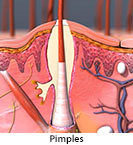
Pimples
What are pimples?
Pimples (pustules or whiteheads) are small blisters filled with pus. They are caused by staph bacteria (unlike acne). They occur most commonly in areas of friction (for example, from tight clothing or rubbing). Pimples are a very mild skin infection and never leave scars.
How can I take care of my child?
The best inexpensive agent for killing the staphylococci that are causing the pimples is a 1:100 bleach solution. Make it by mixing 1 teaspoon of bleach in 1 quart of water. Clean any part of the skin that has old or new pimples with this solution (or with soap and water) for 10 minutes, 3 times a day for 2 or 3 days.
Open any pimples that have come to a head using a needle sterilized by alcohol or flame, and then throw the needle away. The pus should run out without squeezing. Wipe the pus away with a tissue. Then apply an antibiotic ointment 3 times a day until the pimples are gone.
A common mistake is to cover pimples with a Band-Aid. This can cause them to spread. The application of petroleum jelly or any ointment not containing antibiotics can also make them much worse.
How can I help my child prevent pimples?
To prevent spread, ask your child not to touch the pimples or rub his skin. Cut his fingernails short. His hands should be washed frequently. Give him a shower once a day with an antibacterial soap. Be sure your child does not share his washcloth and towel with anyone.
When should I call my child's healthcare provider?
Call IMMEDIATELY if:
- Your child is less than 4 weeks old and has pimples. Note: If your child has erythema toxicum (many small white “pimples”, each surrounded by 1/2-inch red blotches), you do not need to call the doctor.
- Your child starts acting very sick.
Call within 24 hours if:
- New pimples develop after 24 hours of treatment.
- The pimples are not completely gone in 3 days.
- You have other questions or concerns.
Last modified: 2011-06-07
Last reviewed: 2017-06-05

